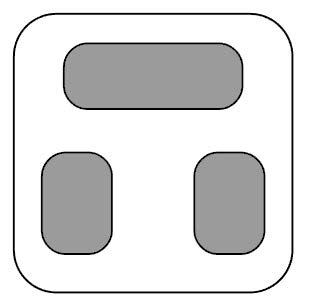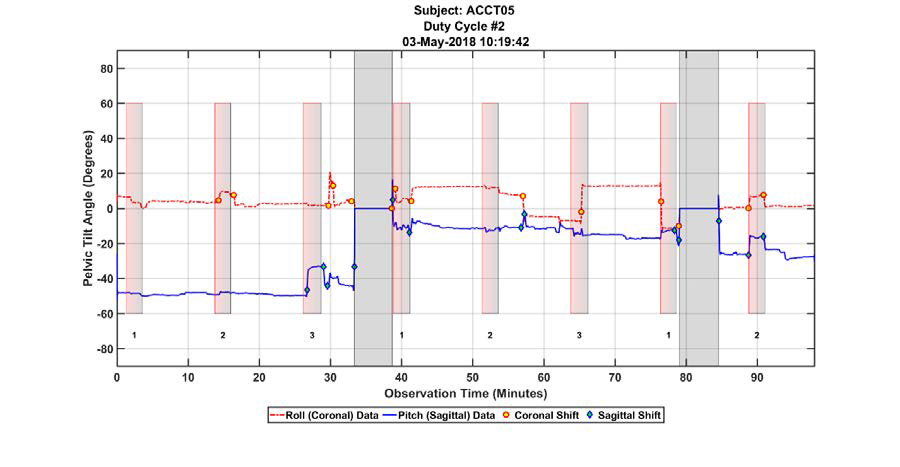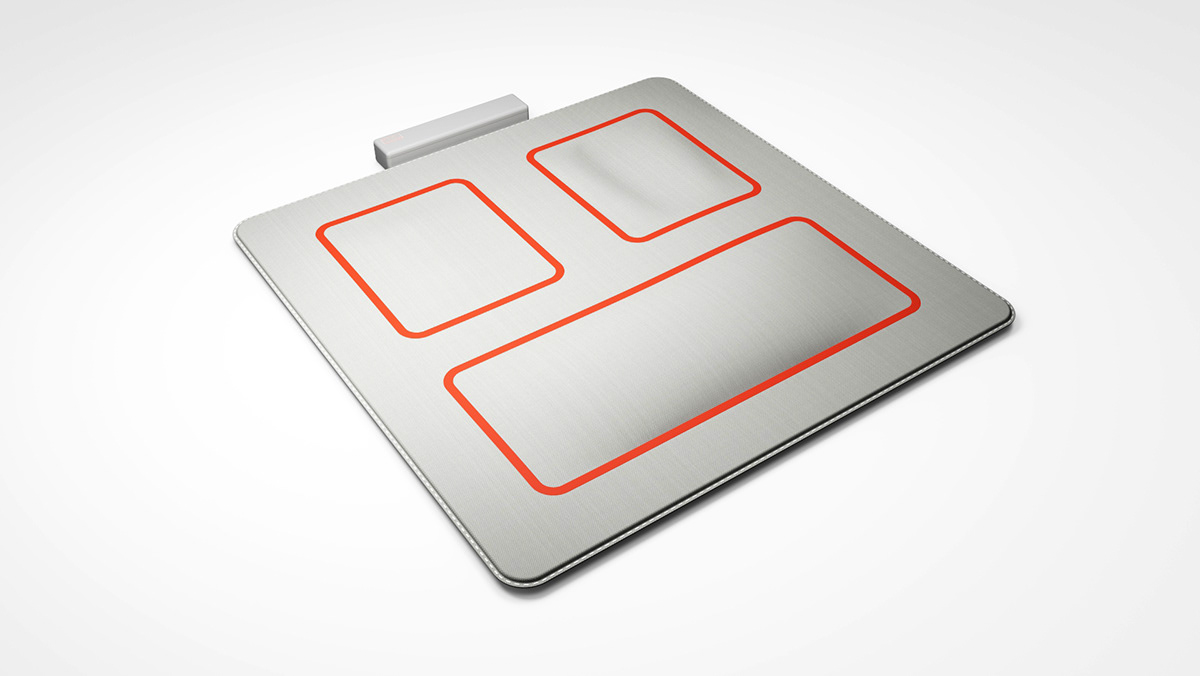ENCOURAGING SEDENTARY WORKERS’ ACTIVE SEATING THROUGH PRODUCT DESIGN
Design Research/ Product Design
The purpose of this project is to design a perturbation system for encouraging active sitting. This product would improve the physical environment within which the sedentary workers work and reduce their incidence of musculoskeletal discomfort. Specifically, the sedentary workers would be able to slightly shift postures without being disturbed by the device through an intervention, therefore, encouraging in-seat movement.
INTRODUCTION

In today’s workplace, sitting has become a more and more common posture. According to Beach’s report, three-quarters of all workers in industrialized countries have sedentary jobs that require sitting for long periods. People also have recognized the relationship between workplace factors and the occurrence of the lower back pain (LBP) (Beach, Parkinson, Stothart, & Callaghan, 2005). Observational studies show breaking up prolonged sitting has beneficial associations with cardiometabolic risk markers (Dunstan et al., 2012).
The purpose of this project is to design a perturbation system for encouraging active sitting. This system would improve the physical environment within which the sedentary workers work and reduce their incidence of musculoskeletal discomfort. Specifically, the sedentary workers would be able to slightly shift postures without being disturbed by the device through an intervention, therefore, encouraging in-seat movement.
DISCOVERY AND DESIGN METHODOLOGY



One purpose of this project is to establish design criteria and specification for a passive perturbation system that encourages postural movement. To fulfill this objective, typical sitting behaviors of sedentary workers were observed and documented.
This section starts by accessing the sitting behavior of sedentary workers work at their workstations. Specifically, the types of chair they user, their normal sitting time, the distribution of sitting pressure and their specific movement during long time sitting were documented. This part laid the foundation and provided the insight for designing better seating design options.

For better understanding the pressure distribution of the subjects while sitting. Researchers used FSA seat sensor as a mean to assess sitting pressure data. Knowing the pressure distribution difference between each posture could provide useful information on how people sit and how they shift their postures.
The study used a hardware that collects and store activity information. A thin sensor mat was placed on the top of the chair to measure forces at the seat interface. During the testing, researcher performed all five postures through and took the screenshot of the pressure distribution. Since the sensor generates a large amount of data, this method is only used to collect short-term sitting information in this case.


The study used a hardware that collects and stores activity information and an analysis system capable of detecting in-seat movement during sitting. The hardware system consists of a data logger and seat sensor. The data logger is able to measure and store in-seat movement for at least 2 work days. It will be mounted underneath the seat surface. It is also designed to avoid impacting the participant’s seating environment or daily activities in any manner.
CREATIVE EXPLORATION
When exploring possible solutions to the issue of preventing prolonged sitting with a perturbation system which can promote active sitting, there are three main avenues to investigate:
1. A perturbation cushion which can invoke postural change
2. A chair that has moving parts which promote active sitting
3. A special device which uses a reminder-based technology
The prior art shows that a portable cushion which can be attached to most kind of office chair will be a promising market. First of all, current products on the market all come with the seat. However, the functional part of a chair which can invoke postural change is not necessarily tied to the chair itself. A portable perturbation system can create large freedom for the target user while choosing such kind of device.

The basic concept is a thin pneumatic pad with three bladders sections. This pad can be used to induce slight postural perturbations using changes in internal air pressure. An inflation sequence will be defined that fills the bladders-one at a time- to slightly shift posture without disturbing the seated individual’s work activity. The bladder should reflect the anthropometry of the pelvis while having a form factor to fit on a regular office chair.
Prototype Development
The whole system can be divided into two parts, which are the pneumatic system and the electronic parts. The electronic parts include an air-pump, a controller, and several solenoid valves. This part provides the air supply for the bladders as well as control the pressure of bladders and gives the right inflation timing.
The micro control unit controls the pump and valves which are connected to the pneumatic part. The pneumatic part includes three bladders which are placed on the base and packaged by fabric. This part allows the cushion to inflate and deflate and creates perturbation which encourages users to shift their weight.

The inflation and deflation of each bladder is control by the solenoid valves. Four solenoid valves are installed on a customized manifest. All the four intake ports of these valves are connected to the pump and they have separate outtake ports. The valve can be activated by 12V Dc power. Since the original manifest produced by the manufacturer only supports three valves, a customized manifest which can hold four valves is made.



Since the pneumatic connecting system had been done, the next step is making the bladders for the system. Based on the design criteria set previously, the maximum pressure of the bladder should be larger than the pump’s ability due to the safety factor. In this case, the pump’s maximum pressure is 55 Kpa. The bladder has two parts, which is the bladder and the port which is used for a connection.




After the bladder was fabricated, the next step was bladder packaging. Since the pipe and port used for connection were made of PVC which might be intrusive for user, some kind of base cover can help reduce that. The first one is made of foam and the second one is made of polymer. The thickness of the foam is 1 inch and the thickness of the polymer is ¼ inch. The size of the cushion is depended on the size of the office chair.


How to arrange the location of the bladders and decide the size of the bladders was the next question. According to the overall concept, there would be three bladders placed on the cushion. The location of the bladders on the cushion can be decided by the body contact part.


IMPLEMENTATION
In order to evaluate the perturbation system’s ability to encourage postural shifts, a study was conducted to collect both qualitative and quantitative data. Specific aims of this study include gaining users’ feedback on the prototype, quantifying data and generalizing results from the subjects and providing insights for further design refinement.


This testing included three sections. Each section lasted for two hours and was deployed on different days. In the first section, subjects were asked to put on the accelerometer then sit on the office chair. They were required to adjust the chair to their comfort level. The cushion’s bladder was not activated in this section. Seat sensor and accelerometer were activated and collected data. In two hours sitting time, subjects were required to work as usual. During the testing, subjects were allowed to take breaks any time they wanted. The time they left the seat was documented by the pressure sensor. After the test was done, subjects were asked to evaluate their sitting experience.

An example of a typical sitting behavior
FINAL DESIGN
The design received positive feedback from the potential users, and the effectiveness of this design was recognized. The creativity of the product, to promote the active seating through passive perturbation was evaluated as effective and comfortable.
Compared with the existing products in the market, the design filled the white space in providing an adaptable device which can promote the active seating and improve the ergonomics of workplace sitting.
The material cost for the cushion was estimated at $160 for the mass production. The price is acceptable when it’s compared to its potential competitors.
Compared with the existing products in the market, the design filled the white space in providing an adaptable device which can promote the active seating and improve the ergonomics of workplace sitting.
The material cost for the cushion was estimated at $160 for the mass production. The price is acceptable when it’s compared to its potential competitors.



This project focus on improving the office worker’s sitting ergonomics and promoting the active sitting of sedentary workers. Future work should conduct more prototype testing for the comfortability as well as long-term use by the potential user. The use case of this design should not be limited to only office workers. All the people who have prolonged sitting such as truck drivers, students, and wheelchair users can be the target user of this product. So there is an opportunity to develop the product in a more specific use case.

